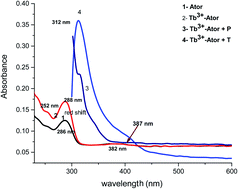Tb3+–atorvastatin doped in poly(ethylene glycol) optical biosensor for selective determination of progesterone and testosterone in serum samples
Abstract
An innovative, simple and cost effective Tb3+–atorvastatin photo probe was designed and used as a core for a spectrofluorometric approach to sensitively determine two vital biological compounds in serum samples. Tb3+–atorvastatin complex displays a characteristic electrical band with λem at 545 nm with significant luminescence intensity, which is quenched in the presence of progesterone and testosterone at two variant sets of pH; 6.2 and 7.5, respectively. The conditions were optimized and the best solvent for operation was found to be acetonitrile with λex at 320 nm. Progesterone and testosterone were assessed in serum samples using the same optimal conditions within concentration ranges of 2 × 10−9 to 2.9 × 10−6 and 3.1 × 10−9 to 4.8 × 10−6 mol L−1, respectively. The proposed luminescence method was validated in accordance to ICH guidelines and found to be accurate, precise and specific and free from any interference. The cost effectiveness and applicability of the method make it a good choice for routine analysis of the two compounds and early diagnosis of chronic diseases associated with abnormalities in their physiological levels.



 Please wait while we load your content...
Please wait while we load your content...